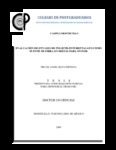Evaluación de envases de polietilentereftalato como fuente de fibra en dietas para ovinos
Abstract
Esta investigación tuvo como objetivo evaluar el potencial de envases de polietilentereftalato (PET) molido como fuente de fibra en dietas para ovinos en engorda, en sustitución de rastrojo de maíz. El estudio tuvo una duración de 60 d con 10 d de adaptación. Se utilizaron 30 borregos machos con un peso vivo promedio de 24.87 ± 1.7 kg alojados en jaulas individuales. Los tratamientos (T) incluyeron tres niveles de envases de PET molido en la dieta (en base a MS): T1 = 0 %, T2 = 10 % y T3 = 20 %. Las variables medidas fueron: ganancia diaria de peso (GDP), consumo de materia seca (CMS), digestibilidad in vivo de materia seca (DIVMS), conversión alimenticia (CA), PET en heces (PETh) y digestibilidad in vivo de materia seca del PET (DIVMSPET). En el líquido ruminal de los borregos se midió: pH, concentración de ácidos grasos volátiles (AGV), nitrógeno amoniacal (N-NH3), concentración de bacterias totales, celulolíticas y protozoarios. Para el análisis de los datos su uso un diseño completamente al azar con tres tratamientos y diez repeticiones. Para evaluar el efecto del tiempo se utilizó el procedimiento MIXED (SAS, 1999). La concentración de bacterias celulolíticas se analizo estadísticamente mediante intervalos de confianza. No se observaron diferencias (P>0.05) en CMS y EA. Mientras que, la GDP fue mayor (P≤0.05) en los borregos alimentados con 10 % de PET (214 g) en comparación con los borregos alimentados con la dieta testigo (202 g) y los alimentados con 20 % de PET (193 g). La concentración promedio de AGV fue similar (P>0.05) entre tratamientos, mientras que, la concentración de N-NH3 aumento (P≤0.05) en los T2 y T3, debido al incremento en la adición de urea en la dieta. El pH ruminal y la concentración de bacterias totales y celulolíticas fue similar (P>0.05) entre tratamientos. Únicamente, la concentración de protozoarios fue menor (P≤0.05) en el rumen de los ovinos alimentados con 20 % de PET. La inclusión de PET (T2 y T3) disminuyó (P≤0.05) la DIVMS de las dietas y aumento el contenido de PET en heces (PETh), aunque, no hubo diferencias (P>0.05) en la DIVMSPET. Se concluye que es posible usar hasta 10 % de PET en sustitución de rastrojo de maíz como fuente de fibra en dietas para ovinos, sin efecto negativo en la eficiencia productiva de los animales, y variables fermentativas y microbiológicas del rumen. _______________ EVALUATION OF POLYETHYLENE TEREPHTHALATE BOTTLES AS A SOURCE OF FIBER IN DIETS FOR RUMINANTS. ABSTRACT : The main objective of this research was to evaluate the potential of ground polyethylene terephthalate bottles (PET) as a source of fiber in diets for growing lambs, in replacement of corn stover. The study took place during 60 d, with 10 d of adaptation period. Thirty male lambs with an average body weight of 24.87 ± 1.7 kg, allotted in individual pens were used. Treatments (T) including three levels of ground PET bottles in the diet (DM bases); T1 = 0 %, T2 = 10 %, and T3 = 20 %. The measured variables were: daily weight gain (DWG), dry matter intake (DMI), in vivo dry matter digestibility (IVDMD), feed efficiency (FE), PET in feces (PETf) and in vivo PET-dry matter digestibility (IVPET:DMD). In the lambs’ rumen fluid was measured: pH, VFA, ammonia (N-NH3), total and cellulolytic rumen bacteria, and protozoa. The data where statistically analyzed in a completely randomized design with three treatments and ten replications. The effect of time was evaluated using the MIXED procedure of SAS (1999). The cellulolytic bacteria concentration data were statistically analyzed by confidence intervals. No differences (P>0.05) were detected on DMI and FE, but the DWG was highest (P≤0.05) in the lambs fed 10 % PET compared with the lambs fed the control diet (202 g) and those fed 20 % PET (193 g). The average VFA concentration was similar (P>0.05) among treatments, while the N-NH3 concentration was higher (P≤0.05) on T2 and T3, due to the input of urea to these diets. The pH, and the total and cellulolytic bacteria was similar (P>0.05) among treatments. Only, the protozoa concentration was lowest (P≤0.05) in the rumen of lambs fed 20 % PET. The addition of PET to the diet (T2 and T3) decreased (P≤0.05) the diet’s IVDMD and increased (P≤0.05) the PET content in feces (PETf), however, no differences (P>0.05) were observed on the IVPET-DMD among treatments. It is concluded that, to use of PET (up to 10 %) on replacement of corn stover as a source of fiber in lambs’ diets is likely, without a negative effect on the animal´s productive efficiency, and rumen fermentative and microbial variables.
Collections
- Tesis MC, MT, MP y DC [403]

